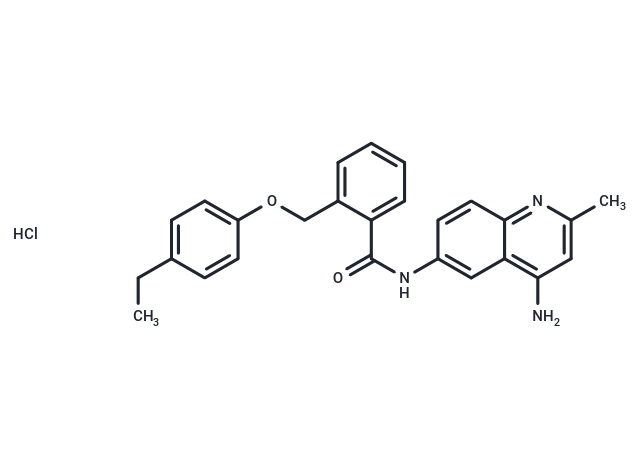Shopping Cart
- Remove All
 Your shopping cart is currently empty
Your shopping cart is currently empty

JTC-801 is a selective opioid receptor-like 1 (ORL1) receptor antagonist with an IC50 of 94 nM and weak inhibitory effects on δ, κ, and μ receptors.

| Pack Size | Price | Availability | Quantity |
|---|---|---|---|
| 5 mg | $41 | In Stock | |
| 10 mg | $66 | In Stock | |
| 25 mg | $144 | In Stock | |
| 1 mL x 10 mM (in DMSO) | $65 | In Stock |
| Description | JTC-801 is a selective opioid receptor-like 1 (ORL1) receptor antagonist with an IC50 of 94 nM and weak inhibitory effects on δ, κ, and μ receptors. |
| Targets&IC50 | ORL1:94 nM |
| In vitro | JTC-801 displays about 12.5-, 129-, and 1055-fold selectivity for ORL1 receptor (Ki = 8.2 nM) over μ-, κ-, and δ-opioid receptors, respectively. JTC-801 does not inhibit forskolin-stimulated cyclic AMP accumulation in human ORL1 receptor-expressing HeLa cells, but it prevents nociceptin-induced inhibition of cyclic AMP accumulation, indicating that JTC-801 possesses full antagonistic activity. [2] In rat cerebrocortical membrane, JTC-801 inhibits ORL1 receptor with IC50 of 472 nM and μ-receptor with IC50 of 1831 nM. JTC-801 completely antagonizes the suppression of nociceptin on forskolin-induced accumulation of cyclic AMP with IC50 of 2.58 μM in HeLa cells expressing ORL1 receptor. [1] |
| In vivo | Oral administration of JTC-801 (0.3-3 mg/kg) antagonizes nociceptin-induced allodynia in mice, and shows analgesic effect in a hot plate test using mice and in a formalin test using rats. [2] In mouse hot-plate test, JTC-801 prolongs escape response latency (ERL) or exposed heat stimulus with minimum effective doses (MED) of 0.01 mg/kg by i.v. or 1 mg/kg by p.o. In the rat formalin test, JTC-801 reduces both the first and second phases of the nociceptive response with MED of 0.01 mg/kg71 by i.v. or 1 mg/kg by p.o. [1] JTC-801 dose-dependently normalizes paw withdrawal latency (PWL). Although JTC-801 does not inhibit a chronic constriction injury (CCI)-induced decrease in bone mineral content (BMC) and bone mineral density (BMD), it inhibits an increase in the number of osteoclasts. [3] Tactile allodynia induced by L5/L6 spinal nerve ligation is reversed by both systemic (3-30 mg/kg) and spinal (22.5 and 45 pg) JTC-801 in a dose-dependent manner. Furthermore, systemic JTC-801 reduces Fos-like immunoreactivity in the dorsal horn of the spinal cord (laminae I/II). [4] JTC-801 produces dose-dependent mechanical and cold anti-allodynic effects with ED50 of 0.83 mg/kg and 1.02 mg/kg, respectively. [6] |
| Kinase Assay | A suspension of membranes from human μ-opioid receptor-expressing CHO-K1 cells in 50 mM Tris-HCl buffer (pH 7.4) containing 5 mM MgCl2 and 10% sucrose is incubated at room temperature for 2.5 h with 0.33 nM 3H-labeled diprenorphine and various concentrations of JTC-801. The membranes are collected by filtration using Whatman 934-AH, and radioactivity is counted with a TopCount A9912V scintillation counter. Nonspecific binding (6.4%) is determined with 10 μM naloxone. Specific binding is calculated by subtracting nonspecific binding from the total binding. Data are the mean±SE (n=3). |
| Alias | JTC801, JTC 801 |
| Molecular Weight | 447.96 |
| Formula | C26H25N3O2·HCl |
| Cas No. | 244218-51-7 |
| Smiles | Cl.CCc1ccc(OCc2ccccc2C(=O)Nc2ccc3nc(C)cc(N)c3c2)cc1 |
| Relative Density. | no data available |
| Storage | Powder: -20°C for 3 years | In solvent: -80°C for 1 year | Shipping with blue ice. | ||||||||||||||||||||||||||||||||||||||||
| Solubility Information | DMSO: 44.8 mg/mL (100.01 mM), Sonication is recommended. Ethanol: 9 mg/mL (20.09 mM), Sonication is recommended. | ||||||||||||||||||||||||||||||||||||||||
Solution Preparation Table | |||||||||||||||||||||||||||||||||||||||||
Ethanol/DMSO
DMSO
| |||||||||||||||||||||||||||||||||||||||||

Copyright © 2015-2025 TargetMol Chemicals Inc. All Rights Reserved.